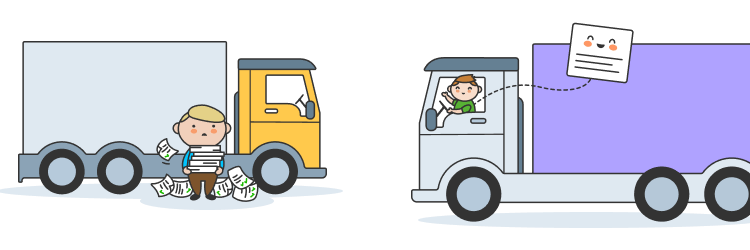In 2024, the Cabinet of Ministers plans to adopt a resolution “On the Implementation of a Pilot Project in the Field of Domestic Freight Transportation.” This will be a new stage in the implementation of eTTN in Ukraine.
With the adoption of the resolution, the state will also resume accreditation of providers. Currently, 24 companies have joined the eTTN project. Vchasno service is among them. With the resumption of accreditation, the number of providers may increase.
In this article, we will discuss how providers are preparing for the new stage of the eTTN project.
Progression to eTTN in Ukraine: what has already been done
Implementation of the eTTN (electronic bill of lading) project began in 2019. The Ministry of Infrastructure, in cooperation with the Ministry of Digital Transformation and the NGO Institute of Analysis and Advocacy, aims to digitize the entire document workflow in the freight transportation industry.
Since the project was launched, the government has improved the system for exchanging electronic bills of lading and introduced new technical capabilities. All this time, providers have been developing solutions that would meet the requirements. So, the project participants went through several stages on the way to a modern eTTN system.

eTTN 1.0
In July 2019, the Ministry of Infrastructure issued Order No. 413 authorizing the use of eTTN. The order permitted eTTNs and related documents (statements of shortage, certificates, details of the goods list, etc.) to be sent via electronic means. Transportation participants could sign them with qualified electronic signatures.
The first eTTNs were stored in ODE services. Drivers had to print out a copy of the eTTN to undergo possible inspections.
eTTN 2.0
On January 1, 2020, the Ministry, together with electronic document workflow providers, launched a pilot project on the use of a single central eTTN database (CDB). Using this database, users exchanged data on cargo transportation, and government agencies checked the validity of eTTNs.
At this stage, the task of providers was to develop a service that was compatible with the CDB. In ODE services, consignors could register eTTNs, and other transportation participants could sign them. Participants could also submit additional information to the eTTN at different stages of transportation.
The Vchasno team actively participated in testing the eTTN system at all stages of the project. They also implemented the eTTN standards in accordance with the changes made by the state.
At Vchasno, we originally intended to create an eTTN as one of the documents in the e-document workflow system. However, based on the experience of implementing eTTN in business, we realized that it should be a standalone service, because eTTN accompanies separate business processes with a large number of participants. Some employees of companies (for example, drivers or storekeepers) do not use other electronic documents except for the eTTN and its accompanying documents. That's why we created the Vchasno.TTN service. It will be integrated with our other services - for example, it will be included in the supply chain in the Vchasno.ODE service.
eTTN 3.0: what the State expects from providers
The state is currently improving the eTTN system to prepare for a full transition to electronic bills of lading and refuse from paper documents.
The system covers all possible scenarios that may arise during transportation and must be documented. For example, overloading in transit, changing the destination, correcting errors in drafting an eTTN, etc. New transportation participants have been added such as freight forwarders, employees of intermediate depots, etc.
Providers have an important task to ensure interoperability between services. This is about creating an eTTN in one service and downloading and signing it in others.
Providers are being tested on how the eTTN service can interact with the system and its ability to fully ensure document workflow during transportation.
After that, the state will accredit the providers. Only accredited services will be able to register electronic bills of lading in the system after Ukraine’s full transition to eTTN.
Providers participating in the eTTN project receive the following statuses: “joined” - those that have joined the project and develop their own eTTN service; “accredited” - those that have been tested and connected to the system. Due to the postponement of the mandatory implementation of eTTN in Ukraine, we have added an intermediate status of “tested”. None of the eTTN providers are currently accredited.
All providers will be tested again after the decision of the Cabinet of Ministers is adopted. Even those who at this stage have the status of “tested”.
How martial law affected the implementation of eTTN
Since the beginning of the war, the state has postponed the mandatory transition to eTTNs several times. It was necessary to build the eTTN system in such a way that it met all the requirements of wartime.
In 2022, when we began discussing amendments to the Law of Ukraine "On Motor Vehicle Transport" with the Verkhovna Rada, Russia began to attack our energy infrastructure. This raised the question: what to do when there is no connection to the Internet? If we oblige transportation participants to switch to eTTN, we must be prepared for this. That is why we are still working with MPs to develop these solutions so that the eTTN system could work under any conditions.
So now the government is finalizing the central database of the eTTN system, which would work under war conditions. Once the Cabinet of Ministers’ resolution comes into effect, the government will start a pilot testing of the system. New providers whose services meet the technical requirements of the system will be able to join it.
Can we expect eTTN 4.0?
With the introduction of the eTTN in Ukraine, the state will continue improving the electronic document workflow system in the transportation sector. The next task of the eTTN project is to align Ukraine’s transportation industry with European Union standards.
eTTN is needed not only within the state. Ukraine has been successfully qualified to participate in the EU4Digital pilot project. It envisages joining the e-CMR, the European Union's unified electronic bill of lading system. This will allow for the future transportation of goods across Europe using a single document. The eTTN is the basis that will allow us to switch to e-CMR in road transportation, as well as in air, water, multimodal, etc.
For this purpose, the government plans to improve the eTTN system in accordance with the European standards for the exchange of electronic information on freight transportation (eFTI). The eTTN providers will also work according to these standards.
Join "Vchasno.TTN" in Telegram
Here we discuss the most important issues related to the introduction of eTTN in Ukrainian business.






